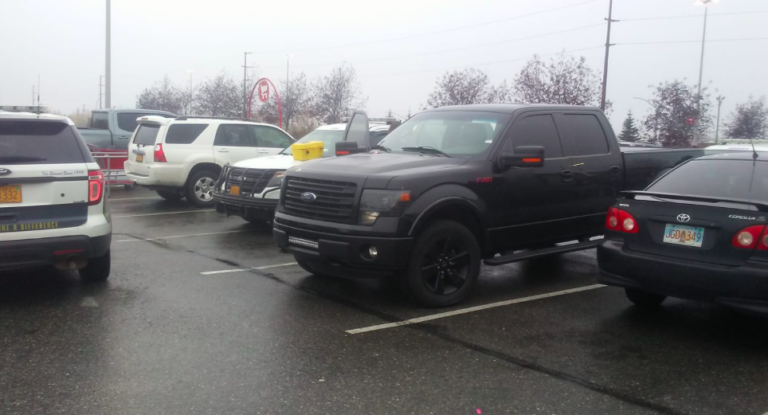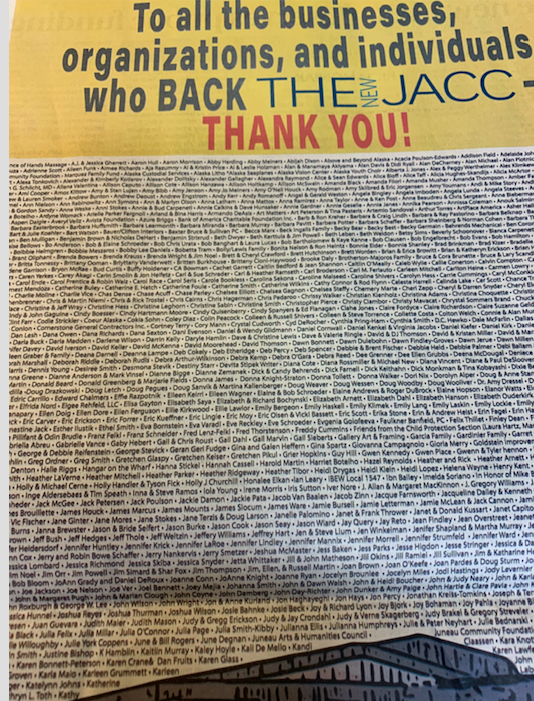A university dripping dollars
THE ANCHORAGE DAILY PLANET
Alaskans should be paying close attention. And they should be more than a little peeved.
The University of Alaska spent half-a-million dollars – $495,000 to be exact – on a PR campaign, “UA Strong,” to keep its state funding after Gov. Mike Dunleavy proposed a $134 million cut in state funding of the institution, KTUU reports.
University officials and supporters fibbed at the time that the cut would amount to 41 percent of the university’s funding; that the university would fail; that the end was near.
Media picked up the fib and repeated it, even in national publications that should have known better.
The proposed cut actually amounted to a 41 percent cut of the Legislature’s proposed $322 million contribution to the university. It would have amounted to something like 17 percent of the university’s complete annual budget, which, counting all revenue streams – including tuition, grants and contracts – hovers near $900 million.
The university, despite is caterwauling to the contrary, is far from broke. “The University of Alaska Foundation manages the Consolidated Endowment Fund totaling $337.5 million, which includes both $191.1 million in Foundation endowments created by gifts from donors over the years, as well as the university’s land grant endowment of $146.4 million,” the foundation says on its website.
While UA and the education industry in Alaska fought to persuade lawmakers to keep the university’s bloated budget in place, the university sought help, KTUU reports. The Anchorage-based agency Brilliant Media Strategies eventually won the bid for the work and the campaign ran from March 6 until the end of the legislative session.
It must have worked. The Legislature approved a budget that shaved only $5 million from state funding for the university. Dunleavy later vetoed an additional $130 million, and the university ran advertisements to raise stink on six Anchorage and Fairbanks TV stations and 26 radio stations.
The governor later signed an agreement with Board of Regents Chair John Davies that would cut $70 million from the university’s budget over three years, instead of $135 million in one.
It is unseemly to us that a university – or any government agency or entity, state or local, for that matter – would essentially put on an expensive, full-court press PR campaign for more government money to spend and play fast and loose with the truth along the way.
We suppose it should come as no surprise. As always with Alaska’s education industry, when you ask how much it needs, the answer is always, “more.”
Election Day around Alaska
For most municipalities and boroughs in Alaska, Oct. 1 is Election Day. Turnout for these elections is typically abysmal, and in many places, the slate for school boards, city councils, and assemblies is thin, with uncontested races being the norm this year.
One race to watch is the Fairbanks mayor’s race between incumbent Jim Matherly and well-funded challenger and hardline Democrat Kathryn Dodge.
JUNEAU’S THREE-HEADED TAX IS ON THE BALLOT
Juneau voters will decide on three ballot initiatives as the city, in an effort to build a new 44,592-square-foot arts facility, proposes three intertwined tax measures to find funds for a new Juneau Arts and Cultural Center.
Conservatives have come out against this rearranging of the chairs on the ship’s deck whilst the budget tempest continues across Alaska, but those in favor of the arts center say that it will send a message to Gov. Michael Dunleavy that Juneau isn’t going his direction.
HOMER VOTES ON PLASTIC BAG BAN
The question on the ballot is quite simple: whether to amend city code to ban single-use plastic carryout bags, by prohibiting sellers from providing those bags under 2.5 millimeters thick.
It’s a yes-no question with no qualifiers for produce bags, meat or fish bags, or little bags for your pharmaceuticals and Homer art items or big bags for your dry-cleaning. Maybe they don’t do dry cleaning in Homer, but you get the drift — this is a vague ballot measure.
SITKA ALSO TO DECIDE ON PLASTIC BAG BAN
A much more detailed ballot measure is in front of Sitka voters, which explains all sorts of exemptions (bags for fish, pharmaceuticals, flowers, ice, etc and other exemptions, including bags for marijuana, naturally.)
KENAI TO VOTE ON BOROUGH MANAGER FORM OF GOVERNMENT
The question for borough residents is: Shall the Kenai Peninsula Borough adopt a manager plan of government, where the chief administrative officer is a manager appointed by the assembly instead of the current form where the elected mayor runs the borough administration? This is a question for voters from an Assembly, some of whom do not like Mayor Charlie Pierce and would like to make him ceremonial.
KETCHIKAN TO DECIDE ON CANNABIS ON-SITE CONSUMPTION
The question for city residents of Ketchikan on Prop. 1 is whether to prohibit the use of marijuana in the same establishments in which it is sold. Chances are good this will fail.
PALMER VOTERS TO DECIDE ON TERM LIMITS
Voters will be advising whether the Palmer City Council should consider enacting term limits for the mayor and council members. The vote is advisory.
BETHEL TO DECIDE ON POT BAN
Voters will decide whether the city will opt out of the state’s liberal commercial marijuana laws. The question is whether Bethel will prohibit importation, sales, cultivation, and testing of marijuana. Voters will also decide if the community will prohibit the sale of alcoholic beverages with the exception of restaurants.
Sweeping education ballot initiative OK’d for signatures
A voter initiative that calls for what supporters say is an Alaska Students’ Educational Bill of Rights was approved by Lt. Gov. Kevin Meyer today, upon advice of the Department of Law.
The group behind the measure can proceed with gathering signatures in petition format, and that would lead to a question being put to voters.
The initiative outlines lofty, undefined, and unquestionably expensive goals that include certain vague outcomes, such as pre-K programs, and a “quality” education for all children in a state where education spending is the highest in the nation per student, but which has some of the poorest outcomes.
The initiative goes so far as to mention that learning begins at infancy, suggesting that in future years, litigation could occur if programs for infants are not implemented statewide. The initiative also mentions better pay for teachers and seems to grant authority that is now at the district level to the state:
The initiative says the State should ensure:
“students of all ages have access to a continuous system of high-quality public education;
“incentives are in place to make voluntary pre-elementary programs as available, affordable, and high-quality as possible;
“investments are made in high-quality, voluntary pre-elementary programs that reflect the best available data on outcomes for students throughout their academic careers;
“public schools are safe, accessible, and modern in order to facilitate an environment conducive to learning;
“public schools receive the tools, including salaries and benefits, to attract and retain highly-qualified professionals in a manner that is competitive with other jurisdictions;
“public schools provide a classroom environment, including class-size, caseloads, and educator workload, that is conducive to frequent one-on-one interactions with educators;
“public schools offer a comprehensive education that includes career and technical education; engineering; world languages; language arts; mathematics; physical education; science; social studies; technology; visual and performing arts; consistent with the provisions of AS 14.35.010-030; and other electives offering enrichment;
“voluntary pre-elementary programs and public schools offer access to extracurricular activities that enhance skillsets beyond the classroom;
“voluntary pre-elementary programs and public schools prepare students to be good citizens and productive members of society;
“public schools provide culturally sensitive curricula, including programs, experiences, and teaching methods that speak to and preserve Alaska Native identity and history, and reflect the needs and cultures of diverse student populations;
“where practicable, voluntary pre-elementary programs and kindergarten through twelfth-grade public education are available at or near each student’s place of residence; and
“voluntary pre-elementary programs and public schools provide for the social and emotional needs of students in order for them to succeed in their program expectations and academic studies.
UNIVERSITY INVESTMENTS
In addition to birth through 12th grade overhaul of education, the initiative calls for an undefined and non measurable investment in university programs, to ensure:
“quality public university education is affordable and accessible to Alaskans of all economic means and provides a clear value when compared to universities in other jurisdictions;
“provide for the maintenance of university facilities; ensure that academic programs and educational technology, including connectivity among university campuses, support lifelong learning opportunities for Alaskans in urban and rural Alaska; encourage research, discovery, and creative activities and, where appropriate, the commercialization of those activities in support of economic development and diversification; ensure coordination with Alaska’s schools in the preparation of educators and education leaders, and through provision of dual enrollment opportunities for academically qualified students; collaborate with the Alaska Department of Education and Early Development and the Alaska Department of Labor and Workforce Development to ensure that Alaska’s students are prepared for a productive career that meets the needs of Alaska’s employers; provide programs and services that build on and contribute to the rich cultural diversity of Alaska’s people.”
The group of educators promoting the measure will need to collect 28,501 signatures and has a year to do so.
The lieutenant governor’s letter approving the initiative for the next stage is here:
Hope Center women’s shelter won’t be forced to admit transgendered
A settlement between the Downtown Hope Center and the Municipality of Anchorage has secured the Anchorage women’s shelter’s right to set rules for its overnight shelter.
Those rules, at present, don’t include allowing men in the door. Nor transgendered individuals, for that matter. Women are sleeping on mats on the floor at the center, in very close proximity and many of them are highly traumatized women who have been living on the street and have significant mental and emotional health needs.
The Hope Center and its legal allies, Alliance for Defending Freedom, sued the Municipality after the Anchorage Equal Rights Commission tried to enforce a municipal equal rights laws that include gay and transgendered people as protected classes.
A man, who claimed to be a women, was refused entrance to the shelter in January of 2017, setting off a series of legal actions. The man, who now apparently presents himself as a woman, filed the initial complaint with the Equal Rights Commission, saying that he had been discriminated against at a place that provides “public accommodation.” He alleged he was refused entry because he is transgendered and cannot be refused service.
At one point, the Equal Rights Commission sued the lawyer who defended the center — Kevin Clarkson — for talking about the case publicly with the media. Clarkson is now the state’s Attorney General. Those charges were later dropped by the Municipality.
Now, Anchorage will pay the Hope Center’s legal team Alliance for Defending Freedom $100,000 to cover its attorneys’ fees and to end the legal dispute, and has agreed that the women’s shelter may not only set its rules, but is allowed to discuss its rules, post its rules, and enforce them.
[Read: Transgender files complaint against women’s shelter]
The Southern Poverty Law Center has designated the Alliance for Defending Freedom a “hate group,” because of its defense of heterosexuality and traditional marriage.
Truck gone, truck found: Quick turnaround with help of Floyd Hall and friends
It was a case of a determined truck owner, a tuned-in Facebook community, and the dogged determination of a legendary stolen car finder, working together to locate the truck that belonged to Mark Skibinski today.
It was also a case of Floyd Hall, the car finder, not accepting a plea deal earlier this year, in a case that landed him in court … but we’ll get to that.
Skibinski’s truck, a black Ford F-150, went missing on a dark and foggy Monday morning, along with a trailer and a jet ski. The trailer and jet ski were abandoned near by, but the truck was out there somewhere.
Skibinski and his fiancé Deantha Crockett took to Facebook and put out the word.
“Please keep an eye out for our truck with jet ski on trailer hooked up to it, stolen from in front of our house early this morning. Black F-150 with veteran license plate VED302. APD has a file, or you can direct message me,” Crockett wrote. Sibinski posted photos and a description, and the Facebook community started waking up.
That’s when radio talk show host Dave Stieren pinged Hall on Facebook.
Then it was spotted at a pot shop, “House of Green,” whose owners released video to Facebook of the guy believed to be driving the truck.
Soon, someone watching the Facebook updates saw the truck driving around Spenard at a high rate of speed. There was a brief chase by a civilian, but police advised to not chase, so the truck’s whereabouts was again in question.

Floyd Hall, seeing the photos, knew the man from Facebook: Mario G. He direct-messaged him on Facebook Messenger with the photos of him, the photos of the truck, and some warnings about who his boyfriend might be in jail (“Big Joe”).
Soon, a friend of the alleged thief notified Hall that the truck had been abandoned at the Southside Target store parking lot. Hall headed to the location as soon as he knew police were on site.
None of this would have been possible, Hall said, had he signed a plea agreement this year with city prosecutors which would have required him to have “no contact” with criminals.
By turning up the heat on the thief on social media, the truck was secured two hours after Hall got involved and started making the truck too hot for the thief to handle.
Whether the man who had been spotted with the truck was the actual thief is an issue for the police to solve. But for now, the Air Force pilot who is the truck’s rightful owner has his ride, his trailer, and his jet ski back, all in one morning.
And Floyd Hall has chalked up another win for the good guys. Hall has recovered hundreds of vehicles for Anchorage residents with help of an ever-growing network of citizens and his core team that he calls the A Team.
Those who wish to help Hall with gas money can do so at his Wells Fargo account # 8217848491
Pass the popcorn
THE ANCHORAGE DAILY PLANET
The state Senate donnybrook over the Permanent Fund dividend rages on.
Gov. Mike Dunleavy has appointed Republican Rep. Josh Revak to fill the Senate seat held by the late Sen. Chris Birch.
Revak was tapped after Dunleavy’s first choice, Rep. Laddie Shaw, was rejected by the Senate majority leadership over his support of a statutory dividend, which this year would be about $3,000. Dunleavy supports the statutory dividend.
The Senate president, Cathy Giessel, and others of her caucus who voted against seating Shaw, want to slash the dividend by nearly half to feed government and feared Shaw would be a vote against, while Birch was a vote for cutting the amount.
Senate Republicans are about evenly divided over the dividend, adopted in 1980 by the Legislature, and have been fighting tooth and nail over the amount this year and how it should be calculated in the future.
The Anchorage Daily News, in an editorial over the weekend, euphemistically described one side as favoring budget cuts and “willing to reduce the dividend in order to preserve an Alaska that looks more like the one we have today with regard to the services the state offers.”
But preserving an Alaska like the one today “with regard to the services the state offers” simply would be preserving a state that spends far beyond its means and expects residents to pick up the tab for its largesse by surrendering their dividends.
The editorial was a little rougher on the other group.
“The second is a PFD diehard caucus, willing to put the state’s annual payments ahead of almost all else, that is strongest in the Mat-Su region, parts of the Kenai Peninsula and pockets of Anchorage,” it said.
We are not sure we would have described it that way. Perhaps, instead of a “diehard caucus, willing to put the state’s annual payments ahead of almost all else,” we would describe the second group as one that believes individuals have a priority over government; that they come first when it come to the dividend; and, that they know best how to spend their money.
The divide is simple to understand: One side believes government comes first; the other, the individual. From where we sit, that is a far more accurate description.
Revak, elected to the House last year, is more than qualified for the appointment, as was Shaw, a Vietnam war veteran and former SEAL. Revak is an Army veteran, a tank crew member and Purple Heart Medal recipient. He served as treasurer for the Abbott Loop Community Council, and director of the Wounded Warriors on Safari Program for the Safari Club International Alaska Chapter.
Revak, who needs confirmation by the same senators who rejected Shaw, supports the statutory dividend. Strangely enough, Giessel and her husband only last year campaigned for Revak, saying in a tweet found by Must Read Alaska, “This is an outstanding young man, army veteran, purple heart, family man.
“You can see the quality person he is by visiting his FB page.”
Pass the popcorn.
Juneau Empire pro-JACC advertisement signed by dead people?
A full-page ad in the Juneau Empire with the names of people supporting a massive arts and cultural center that is Prop. 3 on Tuesday’s ballot contains signatures of several people who are dead, and dozens who don’t live in Juneau.
One reader noted that her mother’s name was included, although she had been dead for over a year. Others who are deceased include Harriet Botelho and Marie Darlin. But there are several more; MRAK was able to identify six signers who have been dead for some time.
Also signing the ad were non-Juneauites such as Jake Metcalfe, Jane Anvik, Vic Fischer, Pat Pitney, Mike and Merry Vediner, Gregg and Judy Erickson, Jeff Bush, and even Rep. Jonathan Kreiss-Tompkins — folks who can’t vote on the tax package on Tuesday and who won’t end up paying the property taxes.
Another person on the list of supporters had written an op-ed against the tax package.
Ramifications for using the names of deceased on an ad are mainly in the court of public opinion. There’s little recourse for “The Partnership” behind the tax package for the huge new arts center, which is led by former Chief Justice of the Alaska Supreme Court Walter Carpeneti and former Alaska Attorney General Bruce Botelho.
The ad contains no apparent disclaimer as required by law for one that is clearly attempting to sway voters by showing an overwhelming amount of support for the three-part tax measure that has confused voters from the beginning.
[Read: Why I’m voting ‘no’ on Juneau’s JACC proposal, Proposition 3]
Which way is the courthouse?
By ART CHANCE
We now have dueling lawsuits and dueling op-eds in Pravda, excuse me, the Anchorage Daily News, about the State’s actions to implement the US Supreme Court’s ruling in Janus v. AFSCME. This pertains to compulsory union dues in the public sector.
The Alaska State Employees’ Association’s Jake Metcalfe is the former head of the Alaska Democrat Party. ASEA has been the cash cow of the AFL-CIO and the Saul Alinsky wing of the Democrat Party since their parent, the American Federation of State, County, and Municipal Employees (AFSCME), AFL-CIO, came to Alaska in 1988 looking to take over a local union and buy a member or two of the Alaska congressional delegation.
They were able to buy a governor in 1994, but it took them until 2008 and some help from the US Justice Department to buy a member of Congress — Mark Begich.
I have the standard ASEA screed about union busting memorized; God knows they said it about me enough times.
Commissioner of Administration Kelly Tshibaka is assuring the unions and the citizenry that the Administration wants to work with the unions to implement the Janus decision.
That is so sweet! I’ve said silly stuff like that too, but I didn’t mean it; I hope she doesn’t either.
Compulsory union dues are the life blood of unions and union money and power are the life blood of the Democrat Party. The 23 states that allow compulsory union membership are deeply blue and no matter what they do, the Democrat hold on those states is relatively secure. The number is down from a peak of 27 union states. De-industrialization in the Midwest has dramatically reduced the number of industrial and trades union members there.
Public employees are much less sympathetic characters than are working class heroes so there has been some erosion of union power in the last decade or so, but they are far from dead.
Here in Alaska changing demographics and conservative/Republican disunity have given unions power they haven’t had since before oil. They aren’t going gently into that good night.
Today the two most powerful interests in Alaska politics are unionized public employees and government funded healthcare. Both care only for keeping their hooves firmly in the operating budget trough.
Environmental and anti-development interests are natural allies because they too are foremost leftists and the particular interest is merely a vehicle. Those of us of Boomer age remember how seamlessly the US left moved from opposition to the draft and the Vietnam War to environmental issues and opposition to development in the early Seventies.
The oil industry is hardly a player unless the issue directly affects the industry. Like the oil industry most of the “private” sector is corporate and based Outside, so they don’t care — unless the issue directly affects them.
Basically, the Alaska res publica is composed of unorganized individual citizens and highly organized powerful interests. It is remarkable that Alaska isn’t a Socialist workers’ paradise like the other Left Coast states, but that day isn’t far away if the current course continues.
I’ve been pretty open about my skepticism towards the Dunleavy Administration’s approach to this issue. Some close to and in the Administration seemed to think that implementing Janus would be their salvation in opposing union power. My reaction was, “yeah, right.”
I became the State’s director of Labor Relations in 2003 almost 20 years after union shops in the public sector were made illegal by the US Supreme Court; half of our labor agreements still had union shops. I told the unions they had to go, and I was on the front page labeled a “union buster.” The unions will give up compulsory union dues in the public sector when they are wrested from their cold, dead fingers.
Some of my conservative/ Republican friends have questioned me, saying, “How do Alaska law and labor agreements trump the US Constitution and the Supreme Court?” To which I reply, “nothing is illegal if nobody enforces the law.”
For almost 20 years nobody had the courage to take on the more powerful State unions regarding their blatantly illegal union shops and union hiring hall systems, and I’ll admit I wouldn’t take them on over the hiring halls because we didn’t have time to get it to the Supreme Court before the end of the term.
If Gov. Dunleavy was going to have this fight, he should have started it as soon as his hand came off The Bible. Now, he is almost a year into his term.
The issue is raised in State courts, where a Republican administration generally and this one particularly can expect to be roughly handled.
The State can expect to be enjoined from making any change in its practices regarding dues collections; that keeps the union cash cow working. If the Superior Court judge is a Democrat s/he’ll let the case drag out as long as possible and ultimately rule for the union on grounds that the current agreements and withdrawal processes don’t violate State law – which they don’t, and that is the real issue. If the judge is a Republican or apolitical, why should s/he put a laser dot on his/her forehead by ruling against the unions/Democrats when s/he can just take a pass, rule on current State law, and buck the issue to the Supreme Court.
There goes at least another year, so we’re now in year three of the Dunleavy Administration. It is easy to kill a year even getting a case before the Alaska Supreme Court and that means it is argued and set for decision in a gubernatorial election year.
The Dunleavy Administration can expect no love from the Supreme Court and the justices can read the paper. Anyone with a brain knows that the Left will pull out all the stops to elect a Democrat or a quisling and if they are successful the whole unpleasantness about union dues will go away as soon as the new Governor takes his/her hand off The Bible. Why should the court make a decision before the election when if the unions win no decision will be necessary.
I don’t believe that the Dunleavy Administration has any real hope of getting this issue decided in State courts before the next gubernatorial election and I further believe that if they don’t, it is extraordinarily unlikely that they or any other Republican candidate will win the next gubernatorial election; the unions/left are too strong and organized and the conservatives/Republicans too divided and disorganized to prevail.
The real issue is why is the question in State courts? Compulsory union dues and dues collections by the employer in accordance with union rules are both perfectly legal under the Alaska Public Employment Relations Act.
There is no question that the Dunleavy Administration’s attempts to change State policy and procedures regarding dues payments and collections violate both State law and the majority of the labor agreements currently in effect.
The problem is that the State law and the labor agreements violate the federal Constitution. So, why is the State in the Alaska Superior Court rather than the federal Alaska District Court? Maybe somebody who knows more about standing and jurisdictions of federal courts than I do can give a satisfactory answer, but it seems to me that a federal question should be in the federal courts.
As I said in my column on Aug. 28, the federal route isn’t an easy one and the Ninth Circuit has shown itself willing to stand the Constitution on its head to protect leftist interests, but if Alaska can get the matter to the US Supreme Court, it will prevail.
Somebody persuade me that the State isn’t in the wrong courthouse.
Art Chance is a retired Director of Labor Relations for the State of Alaska, formerly of Juneau and now living in Anchorage. He is the author of the book, “Red on Blue, Establishing a Republican Governance,” available at Amazon.








